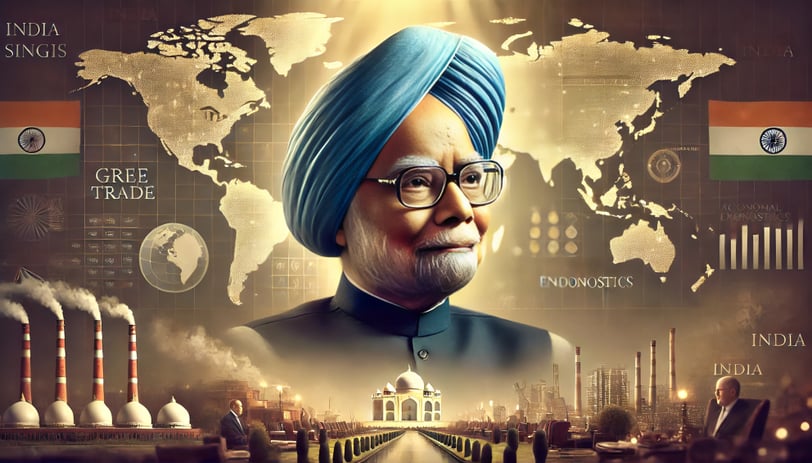The Legacy of Dr Manmohan Singh, Prime Minister of India-2004-2014
Trained at Oxford and Cambridge, India’s Former Prime Minister Dr Manmohan Singh quietly said goodbye to this world on December 26, 2024; but his legacy is being heard too loud globally.
EXPERT ANALYSIS
GeopoliticsTv Team
1/9/20254 min read


Dr Manmohan Singh, who was the Prime Minister of India from 2004-2014, left the world quietly on December 26, 2024. But his legacy in India and the world is being heard loud and clear as many people are taking to social media to analyse and appreciate his works in the field of socio-economic change not just in India, but across countries which are linked with India in terms of free trade and industries.
Dr Singh was born in Pakistan’s Punjab region, whose family later migrated to India upon partition of the country in 1947. With his initial studied in the University of Punjab, Dr Singh later studied in Oxford and Cambridge Universities of England, and probably was a rare person so learned academically to occupy supreme constitutional position in recent times.
The biggest contribution of Dr Singh with his huge learnings and experience in the field of economy, was his liberalizing Indian economy and making it play as a player in the global free market. He opened up the Indian economy connecting it with the free global economy when he was the finance minister of the then Prime Minister P.V. Narasimha Rao from 1991-96. When Narasimha Rao took over as the Prime Minister, India had huge fiscal deficit and its balance of payments and current account deficits were huge. Indian had a foreign reserve that was just enough for barely three weeks of foreign imports. Instead of choosing a politician, Rao decided to induct in his cabinet an economist, Dr Manmohan Singh for the Finance Ministry. Rao gave him full freedom to decide the course of economy of the country, which helped Dr Singh to navigate the economy of the country with his vast learning and experience. First as a professor of Economics, then as a Governor of the Reserve Bank of India, as the Economic Advisor to the Government of India, as the Finance Secretary of Government of India and then as the Vice Chairman of the Planning Commission, Dr Singh had seen it all before his new job as the finance minister.
India before him followed a closed economy wherein foreign investment was cautiously kept away. This was the need of the time when Jawaharlal Nehru took over the reins of the country soon after its Independence from a long British Raj. However, over the years, Indian economy had become staggard. Government control was too much, and Licence Raj ruled the economy. This is when Dr Singh decided to end the License Raj and liberalise the economy of the country. several structural reforms were put to place. But, Dr Singh, though said to be initially conservative in outlook, found that the situation of India fit to be liberalized to the global free trade. Foreign investments and partnerships of foreign countries, like the famous Suzuki-Maruti partnership, to give an example, brought in huge socio-economic change. Jobs were created, engineering and technology boomed, huge flow of money took place in the society, a rich middle-class emerged, who now wanted more luxurious foreign goods as it had gained purchasing power. In later years, Indian companies had been investing in other countries. India being a huge market, countries from all over the world saw India as a destination for free trade and economy—thus, Dr Singh impacted not just Indian economy but the world economy too. From a sleepy nation, the credit to change India into a global economic power, to a great extent, goes to Dr Singh.
After the liberalisation of economy, India was forced to become a player in the global free market. The biggest push, however, came in the field of education. Due to foreign investments in the country by way of partnership of foreign companies with Indian companies, numerous industries owned by private companies, came up. This required technologically trained personnel to man different posts of the companies and the industry. As a result, there was a boom in number of technical and engineering institutions in the country. Youths took to engineering and technical courses in large numbers. As a result, the new industries had not only enough supply of well-trained technical personnel, but there were well-trained youths who wanted to explore job opportunities abroad. Even foreign nations started providing job opportunities to engineering and technology graduates. Liberalisation, thus, connected Indian with globalisation. Private companies found new vistas for investment; and employment opportunities grew.
When Dr Singh was the Prime Minister (2004-2014), the world passed through a nasty economic recession, particularly during the close of his first term. Rich nations like the United States, too were badly affected. However, the foresightedness of Dr Singh ensured that global recession had minimum impact in Indian economy. Dr Singh dealt with two presidents of the United States of America, President George W. Bush, and President Barack Obama; and both the presidents held him in high esteem. And so did many top leaders of the world of the day.
The credit of transforming India from a sleepy economy to a resurgent global economy majorly goes to Dr Singh. Today, many Indian companies have become huge and have expanded their operations in many countries across the globe.
This apart, many multinational companies that belonged to different nations of the globe, have their operations in India too. India offers them a huge market for their products. The impact of the legacy of Dr Singh, thus, is not restricted to India alone, but it is global. With the passing away of Dr Singh, an epoch may have ended in Indian economy, and the world lost a rarest of rare economist with a training from world’s best universities who put his learnings to practice in changing the economic scenario of the globe.
